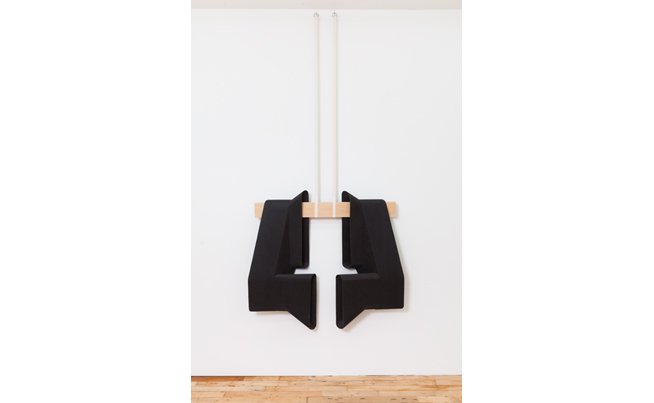
FEMALE GENIUS: Diane Simpson in PIN-UP Magazine
Dec. 9, 2015
NEW YORK – Nobody minds being called a genius. But the addition of “female” certainly complicates things. If you’re a genius, you’re a genius, no matter your gender. In his 1994 book Profiles of Female Genius, Gene L. Landrum portrayed 13 “creative women who changed the world,” including Estée Lauder, Oprah Winfrey, and Margaret Thatcher. While two decades later Landrum’s tone — he spoke of women’s “tendency to take abnormal risks,” their “visionary perspective,” “intuitive operating style,” and “boundless energy” — may come off as patronizing, it is still a fact that the worlds of art and architecture remain predominantly male. In this special feature we portray seven female artists from different generations, two of whom gained fame late in life after being ignored or marginalized in a milieu that was long exclusively male. While the individual bodies of work by Lena Henke, Carmen Herrera, Sahra Motalebi, Diane Simpson, Avery Singer, Mickalene Thomas, and Kaari Upson are very diverse, and involve different media, what they have in common is in an interest in or connection to architecture, be it through their treatment of space, their choice of subject matter, or their handling of materials. While some of them have an architectural background, none of them are practicing architects. But each artist, in her own way, redefines our conception of space. And that, in and of itself, is a sure sign of genius, no matter what gender.
— Julie Klein
At a recent opening of a New York art fair, someone was overheard describing the 80-year-old sculptor Diane Simpson as “just so badass!” The description couldn’t be more apt. But why exactly? Because she’s still making her beguiling works to this day? Because she’s been making bold work for decades during which female artists were marginalized? Because the skill and construction of her sculptures is so perfect they almost seem industrially fabricated? The answer, of course, is all of the above and more.
Simpson’s sculptures and drawings gain their conceptual traction from the slippage between perception and representation. They are at once familiar but abstracted, anthropomorphic but unfeasible, entreating but hermetic, three-dimensional but flattened. Her oeuvre involves complex amalgamations of historically-sourced subject matter — predominantly clothing and architecture — that she meticulously reconstructs out of carefully considered materials. The sculptures read as nuanced takes on the subjects that ispired them, as well as highly original structures in their own right, but also, of course, contain something of the personal history of the artist herself.
Diane Simpson was born Diane Klafter in 1935 in Joliet, Illinois. She received both her Bachelor’s and Master’s in Fine Arts from the School of the Art Institute of Chicago (in 1971 and 1978, respectively), and her artistic education was dominated by the visual milieu of Art Deco and Modernist architecture in Chicago — geometric lines and surface ornamentation. In the late 1960s, a group of artists known as the Chicago Imagists, who combined Surrealism, Art Brut, personal narrative, and comic art, began to exhibit work at the Hyde Park Art Center in response to New York’s Pop Art. Claiming the oft-ghettoized aesthetic world of vernacular art, the Chicago Imagists redefined the Postmodern subjectivity of Pop Art. There’s currently a renewed interest in the Chicago Imagists, and more specifically in the work of Simpson, who was always somewhat on the periphery of the movement.
Simpson’s art centers around a three-step process: take a subject, create a unique two-dimensional isometric drawing of that subject, and render this drawing into a three-dimensional sculpture. (Each sculpture is intended to be sold with its drawing, which can also be used as an installation manual.) Her seminal 1983 exhibition Samurai, at Phyllis Kind Gallery in Chicago, featured nine sculptures inspired by Japanese samurai armor and kimonos made from medium-density fiberboard.
Since then her exploration has expanded, among others, to symbols of domesticity, Elizabethan excess, and ecclesiastical vestments, and yet her sculptures always feel atemporal and polyvalent, eschewing easy classification. Take Apron X (2005), for example, where she used leather wrapped around a metal armature to conjure up a frilly 1940s apron, producing a monumental composition that has something of the Mesoamerican pyramid or the Art Deco skyscraper about it. In Formal Wear (1998), two rigid black polyester sleeves hang from a bare poplar bar, drawing upon the exaggerated clothing in The Three Princesses of Saxony (Lucas Cranach the Elder, c. 1530), the painting that inspired it, while also suggesting the simple gesture of someone praying. And similarly Doublet (1985) borrows form and line from the eponymous male waistcoat, but is transformed through Simpson’s deft hand and oil-stained redwood into an elaborate pagoda.
As feminist art historians Helen Molesworth, Lisa Tickner, and Mignon Nixon have pointed out, the history of art made by women is a history of omission. A more fecund approach may be to look at artistic allies and predecessors in a horizontal fashion — not mothers and fathers, but brothers, sisters and cousins — to elucidate the discourse around different art practices. Simpson may be chronologically and geographically associated with the Chicago Imagists, but her work is perhaps better understood as being in dialogue with artists like Eva Hesse and Martin Puryear, as well as Vincent Fecteau and Tauba Auerbach. The public will soon be given a chance to make up its own mind at a 30-year survey exhibition — Simpson’s first solo show at an art museum — opening at the Institute of Contemporary Art/Boston in December 2015.
